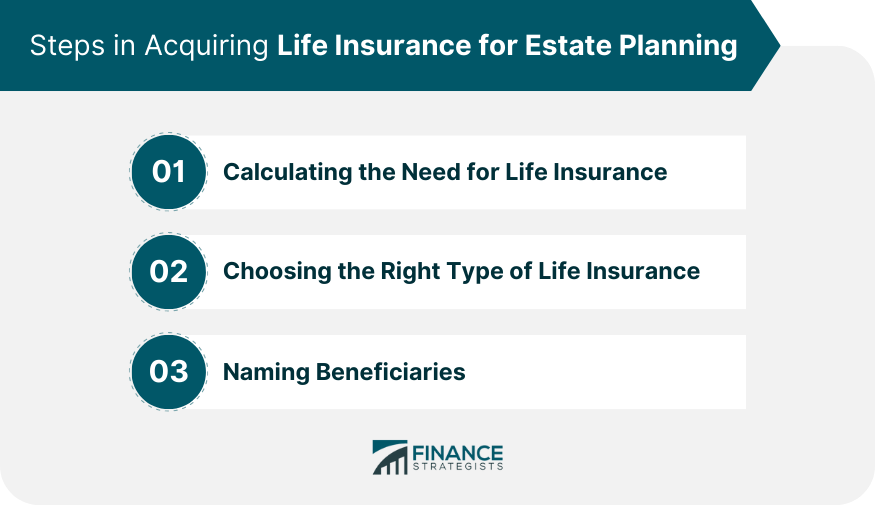Using life insurance in estate planning is a strategic approach that ensures your loved ones' financial security after your demise. This involves acquiring a life insurance policy and designating it in a way that aligns with your estate planning objectives. The main purpose of this approach is to provide immediate financial aid to your family, cover estate taxes and related expenses, serve as income replacement, and facilitate fair distribution of assets. The context of this strategy spans various demographics and financial situations, underscoring its relevance for individuals with dependents, substantial debt, or those looking to maximize their estate's value while minimizing potential tax implications. It reiterates the role of life insurance as an essential tool in comprehensive estate planning. Upon the death of the insured, life insurance can provide immediate funds to the family or heirs. This financial support can be especially crucial during a difficult time when income might be disrupted. The proceeds from life insurance can be used to pay estate taxes and other related costs such as funeral expenses or debts. This prevents the need to sell off assets hastily and potentially under unfavorable market conditions. If the insured has dependents who rely on their income, life insurance can serve as a replacement for lost income, providing ongoing financial support. Life insurance can help ensure a fair distribution of assets among heirs, especially in situations where certain assets (like a family business) cannot be easily divided. If an estate consists largely of illiquid assets like real estate, life insurance can provide the necessary liquidity to cover estate taxes and other costs, avoiding the need for a fire sale of assets. By setting up an Irrevocable Life Insurance Trust, life insurance proceeds can be excluded from the taxable estate, potentially reducing estate tax liability. Different types of life insurance policies can be used in estate planning, each offering distinct benefits. Term Life Insurance: Provides coverage for a specific term. It is often cheaper but does not accumulate cash value. Whole Life Insurance: Offers lifetime coverage with a cash value component, acting as a savings or investment vehicle. Universal Life Insurance: Provides more flexibility in premium payments and death benefits, also accumulating cash value. Variable Life Insurance: Lets policyholders invest the cash value into a variety of investment options. Determining your financial obligations, your current debts, and the financial needs of your dependents. Once you have a clear understanding of these elements, you can estimate the amount of life insurance required to protect your estate and loved ones. This depends on various factors, including your age, health, financial status, and long-term goals. Term life, whole life, universal life, and variable life insurance are the most common types, each with distinct features and benefits. These are the individuals or entities that will receive the death benefits from your policy. This decision plays a crucial role in ensuring the wealth transfer process aligns with your wishes. An ILIT is a strategic tool in estate planning that allows for increased control over your life insurance policies and their proceeds. Establishing an ILIT has several advantages. One primary benefit is the potential for estate tax reduction. By owning the life insurance policy, the ILIT removes it from your taxable estate, potentially reducing estate tax liability. Secondly, an ILIT provides enhanced control over the insurance proceeds. The terms of the trust dictate the distribution of benefits, allowing you to guide when and how beneficiaries receive funds. Thirdly, ILITs offer creditor protection. Since the ILIT is the legal owner of the policy, it can shield the policy's proceeds from your potential creditors. Lastly, the ILIT can provide liquidity to your estate. This can be vital in scenarios where your estate primarily comprises illiquid assets like real estate or a family business, as the proceeds from the life insurance can cover estate taxes and other costs without the need to sell assets. Setting up an ILIT involves a few key steps. 1. Consult With an Estate Planning Attorney: Establishing an ILIT is a complex process that requires professional guidance. 2. Draft the Trust Document: This document outlines the terms of the trust, including trustee designation and beneficiary details. 3. Fund the Trust: You'll need to transfer ownership of your life insurance policy to the trust or have the trust purchase a policy. 4. Maintain Trust: Ensure premium payments are made regularly, and review the trust periodically to align with changes in estate planning goals or tax laws. In most cases, the death benefits from a life insurance policy are not subject to income tax. However, if the death benefit is included in the insured's estate, it could be subject to estate tax. If the insured person owns the policy at the time of death, the death benefit could be considered part of the estate and be subject to estate taxes. Establishing an ILIT can help avoid this situation. Avoiding common pitfalls can help optimize the benefits of using life insurance in estate planning. Some common mistakes include failing to regularly review and update life insurance policies, making improper beneficiary designations, and not incorporating life insurance into a broader estate plan. Life insurance emerges as a crucial element in estate planning due to its versatile functions. It serves to ensure immediate financial support for the family, assists in settling estate taxes, acts as an income replacement, and promotes equitable asset distribution. Selecting the right type of life insurance policy — whether term, whole, universal, or variable — depends on individual circumstances and long-term objectives. Creating an Irrevocable Life Insurance Trust can further enhance control over policies, provide creditor protection, and facilitate liquidity to the estate. It is essential, however, to avoid common missteps such as neglecting regular policy reviews and making unsuitable beneficiary designations. Through careful planning and execution, life insurance can be a powerful tool in safeguarding your loved one's financial future and fulfilling your estate planning goals.Life Insurance in Estate Planning Overview
Uses of Life Insurance in Estate Planning
Provides Immediate Funds
Estate Taxes and Expenses
Income Replacement
Equitable Distribution of Assets
Estate Liquidity
Reducing Estate Taxes

Types of Life Insurance Policies for Estate Planning
Steps in Acquiring Life Insurance for Estate Planning
Calculating the Need for Life Insurance
Choosing the Right Type of Life Insurance
Naming Beneficiaries

Establishing an Irrevocable Life Insurance Trust (ILIT)
Benefits of an ILIT
How to Set up an ILIT
Tax Implications of Life Insurance in Estate Planning
Life Insurance, Death Benefits, and Taxes
Estate Tax Implications
Common Mistakes in Using Life Insurance in Estate Planning
The Bottom Line
Using Life Insurance in Estate Planning FAQs
Life insurance can be used in estate planning to provide immediate funds for the family, pay estate taxes and other related expenses, replace income for dependents, and ensure equitable distribution of assets among heirs.
Using life insurance in estate planning is important because it provides financial security for the insured's loved ones, offers significant tax benefits, and allows the policy owner to maintain control over the distribution of wealth.
Term life insurance, whole life insurance, universal life insurance, and variable life insurance can all be used effectively in estate planning. The choice depends on individual needs, financial circumstances, and estate planning goals.
Common mistakes to avoid include failing to regularly review and update life insurance policies, making improper beneficiary designations, and not incorporating life insurance into a broader, comprehensive estate plan.
To maximize the benefits, consider establishing an Irrevocable Life Insurance Trust (ILIT) to remove the death benefit from the taxable estate, providing liquidity to the estate and control over the distribution of benefits. Also, understanding tax implications and choosing the right life insurance policy is essential.
True Tamplin is a published author, public speaker, CEO of UpDigital, and founder of Finance Strategists.
True is a Certified Educator in Personal Finance (CEPF®), author of The Handy Financial Ratios Guide, a member of the Society for Advancing Business Editing and Writing, contributes to his financial education site, Finance Strategists, and has spoken to various financial communities such as the CFA Institute, as well as university students like his Alma mater, Biola University, where he received a bachelor of science in business and data analytics.
To learn more about True, visit his personal website or view his author profiles on Amazon, Nasdaq and Forbes.











